Contents
- 1 TOP 10 Downhill MOUNTAIN BIKES OF 2025
- 2 our top 10 picks
- 3 1. Santa Cruz V10 2025 Edition
- 4 PROS
- 5 CONS
- 6 2. Commencal Supreme DH V6
- 7 PROS
- 8 CONS
- 9 3. Canyon Sender CFR 2025
- 10 PROS
- 11 CONS
- 12 4. Trek Session 9
- 13 PROS
- 14 CONS
- 15 5. Pivot Phoenix 29 2025
- 16 PROS
- 17 CONS
- 18 6. Nukeproof Dissent 297
- 19 PROS
- 20 CONS
- 21 7. GT Fury Carbon Ultimate
- 22 PROS
- 23 CONS
- 24 8. Specialized Demo Race 2025
- 25 PROS
- 26 CONS
- 27 9. Norco Aurum HSP C2
- 28 PROS
- 29 CONS
- 30 10. Scott Gambler 920
- 31 PROS
- 32 CONS
- 33 Downhill Mountain Bike Buyers Guide
- 34 Final Thoughts
TOP 10 Downhill MOUNTAIN BIKES OF 2025
Downhill mountain biking is one of the most adrenaline-pumping disciplines in cycling, pushing both riders and their bikes to the absolute limit. Whether you’re dropping into technical rock gardens, sending it off massive jumps, or tackling world-class racecourses, having the best downhill mountain bike is essential for performance and safety.
The global mountain bike industry is booming, expected to hit $16.9 billion by 2027, with downhill bikes playing a significant role. Advances in frame technology, suspension, and geometry mean that 2025’s lineup of best downhill bikes is better than ever.
In this guide, we’ve researched and reviewed the 10 best downhill mountain bikes of 2025, covering features, pros and cons, and what makes them stand out.
our top 10 picks
These are our top 10 picks for the best downhill mounatin bikes in the current market
1. Santa Cruz V10 2025 Edition
The Santa Cruz V10 2025 remains one of the best downhill mountain bikes for professional racers. With a VPP suspension system, this bike offers incredible traction and stability, making it a top choice for those tackling steep and rough terrain. The Fox Factory suspension ensures a smooth ride, absorbing big drops and high-speed hits with ease. The adjustable geometry allows riders to fine-tune their setup to match the track conditions, a feature that serious downhill riders will appreciate.
For 2025, the updated carbon layup makes the frame even lighter while maintaining durability. Whether you’re looking for a podium-finishing race bike or simply want a top-tier downhill MTB, the V10 delivers performance at the highest level. However, with a premium price tag, this bike is best suited for experienced riders looking for a race-ready machine.
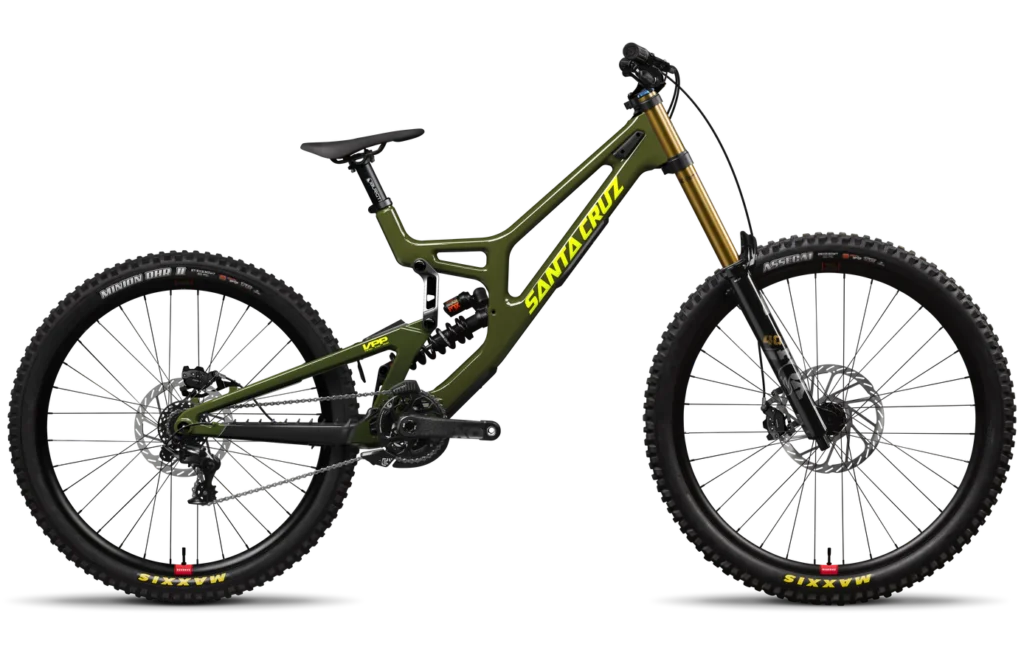
- Price: $7,499 – $9,999
- Suspension: 215mm rear, 203mm front
- Frame Material: Carbon CC
- Weight: 35.5 lbs
- Brakes: SRAM Code RSC, 220mm rotors
- Drivetrain: SRAM X01 DH 7-speed
- Geometry: 63.3° head tube angle, adjustable chainstays
PROS
CONS
- High-pivot suspension for better traction
- Lightweight carbon frame
- Race-ready design
- Expensive
2. Commencal Supreme DH V6
The Commencal Supreme DH V6 is a downhill racing powerhouse, boasting an advanced Virtual Contact System (VCS) that enhances traction and improves handling over rough terrain. Designed for aggressive riders, the updated rear triangle provides increased stiffness, ensuring stability when hitting high-speed descents.
One of the standout features of this bike is its flip chip adjustability, allowing riders to tweak the geometry for different tracks. The aluminum frame keeps costs lower than some carbon competitors while offering impressive durability. While it’s heavier than carbon models, the additional weight provides added stability on steep terrain.
Perfect for those looking for a race-ready bike without the high price tag of carbon frames, the Supreme DH V6 is a favorite among competitive riders and privateers alike.

- Price: $5,900 – $7,600
- Suspension: 220mm rear, 200mm front
- Frame Material: Aluminum
- Weight: 37 lbs
- Brakes: TRP DH-R Evo
- Drivetrain: Shimano Saint 7-speed
- Geometry: Flip chip adjustable
PROS
CONS
- High Virtual Contact System for better traction
- Redesigned rear triangle for added stiffness
- Proven race geometry
- Heavier than carbon models
- Suspension might be too stiff for casual riders
3. Canyon Sender CFR 2025
The Canyon Sender CFR 2025 is built for speed, stability, and performance. Designed with motocross-inspired suspension kinematics, this bike offers enhanced small bump sensitivity, making it a standout choice for riders who prioritize smooth handling on technical tracks.
The full-carbon frame ensures lightweight agility without compromising strength. It features an adjustable headset and flip-chip dropouts, allowing riders to fine-tune the bike’s reach and chainstay length based on personal preference and trail demands. The Magura MT7 Pro brakes provide exceptional stopping power, giving riders confidence to push limits on steep descents.
For those looking for a lightweight and customizable downhill MTB, the Canyon Sender CFR 2025 is a strong contender.

- Price: $5,499 – $6,999
- Suspension: 200mm front & rear
- Frame Material: Carbon
- Weight: 34 lbs
- Brakes: Magura MT7 Pro
- Drivetrain: SRAM GX DH
- Geometry: Adjustable reach and chainstay
PROS
CONS
- Lightweight carbon frame
- Adjustable headset for better fit
- Motocross-inspired suspension for big hits
- Expensive for beginners
- Stock wheels could be upgraded
4. Trek Session 9
The Trek Session 9 is one of the most proven downhill bikes in modern racing. With decades of World Cup history, this bike is designed for speed and stability on the roughest terrain.
One of the standout features is Trek’s Active Braking Pivot (ABP), which ensures the bike maintains suspension performance even under heavy braking. This means more control when dropping into steep, technical sections.
The Session 9’s geometry is fine-tuned for racing, with a low bottom bracket, slack head tube angle, and size-specific reach for optimal handling. It also features RockShox Boxxer Ultimate suspension, providing a plush but responsive ride that excels at absorbing high-speed impacts.
For 2025, Trek has improved frame stiffness without adding weight, making it more responsive on fast sections. While not the lightest bike in the lineup, its balanced geometry and stable feel make it an excellent choice for competitive riders.
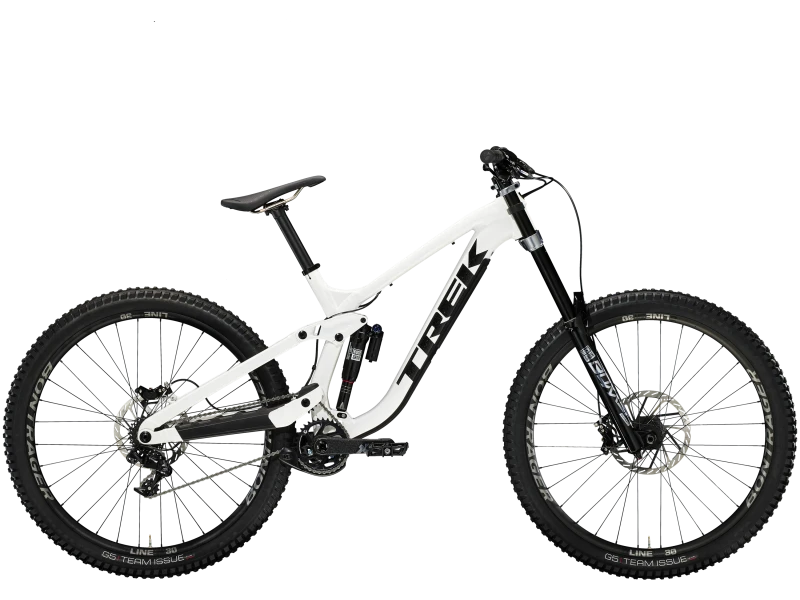
- Price: $5,500 – $7,200
- Suspension: 200mm front & rear
- Frame Material: Alpha Platinum Aluminum
- Brakes: SRAM Code RSC
- Drivetrain: SRAM X01 DH 7-speed
- Geometry: 62.1° head tube angle, size-based reach adjustments
PROS
CONS
- Proven race-winning design
- Active Braking Pivot (ABP) improves control
- Stable, predictable handling
- Not the lightest option
- Stock shock tune may need adjustments
5. Pivot Phoenix 29 2025
The Pivot Phoenix 29 is an elite-level downhill bike built for riders looking to shave seconds off their race times. With DW-link suspension, this bike offers exceptional traction, making it a dream to ride on technical tracks.
One of the lightest downhill bikes in this category, the Phoenix 29 is optimized for aggressive racing. The Fox Factory 40 fork and Fox X2 shock give it a super smooth feel over roots and rock gardens.
What sets this bike apart is its ultra-stiff carbon frame, allowing precise handling at high speeds. It also features a long reach, low bottom bracket, and a relaxed head angle, making it super stable on fast descents.
The Phoenix 29 is designed purely for racing, which means it may not be as playful as other bikes. But for serious competitors, this is one of the fastest downhill bikes on the planet.
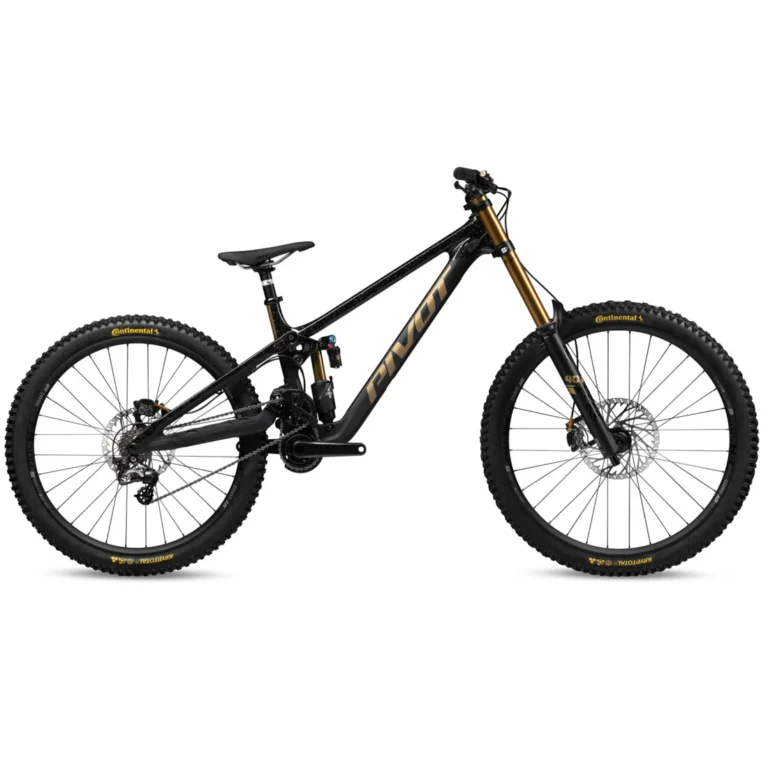
- Price: $8,299 – $9,649
- Suspension: 190mm rear, 203mm front
- Frame Material: Carbon
- Weight: 33.5 lbs
- Brakes: Shimano Saint
- Drivetrain: Shimano XTR 7-speed
PROS
CONS
- Super lightweight carbon frame
- DW-link suspension provides unmatched traction
- Optimized for elite racing
- Very expensive
- Not as forgiving for casual riders
6. Nukeproof Dissent 297
The Nukeproof Dissent 297 is a race-bred machine developed on the World Cup circuit. Designed for privateer racers, it delivers high-end performance at a more affordable price point.
The adjustable suspension kinematics allow riders to fine-tune rear shock progression, making it incredibly versatile across different race tracks. The geometry is slack and aggressive, giving riders confidence when tackling steep, gnarly descents.
It’s slightly heavier than some carbon competitors, but offers incredible durability—perfect for those who ride hard and don’t want to worry about frame damage.
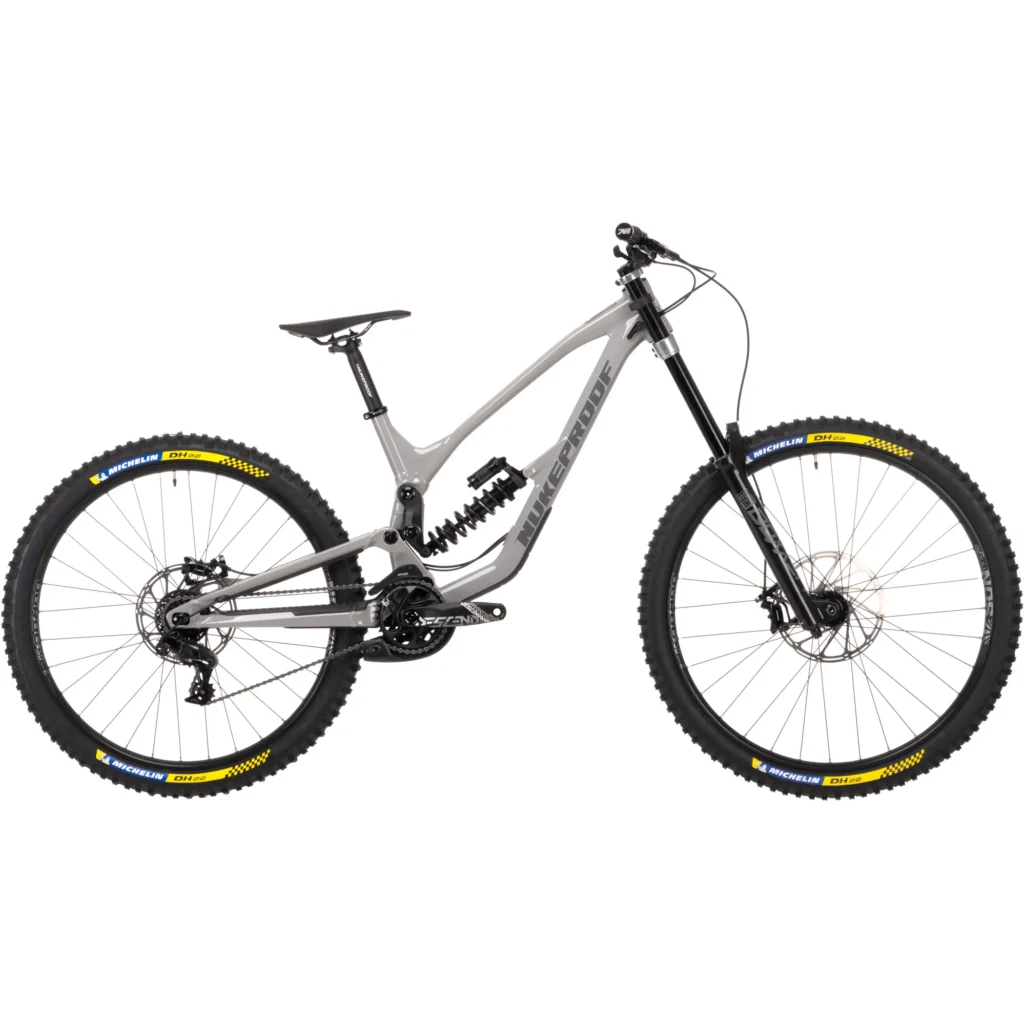
- Price: $3,199 – $6,999
- Frame Material: Carbon or Alloy
- Suspension: 200mm front & rear
- Brakes: SRAM Code RSC
PROS
CONS
- Great value for privateer racers
- Durable, stiff frame
- Adjustable suspension settings
- Slightly heavier than high-end carbon options
- Stock shock tune might need tweaking for lighter riders
7. GT Fury Carbon Ultimate
The GT Fury Carbon Ultimate is a downhill beast designed for both racing and freeride adventures. GT’s LTS suspension system gives this bike an incredibly planted feel on rough terrain, making it ideal for riders who prefer high-speed stability over a more nimble ride.
One key feature is the floating bottom bracket design, which allows for better pedaling efficiency and shock absorption. This makes the Fury surprisingly comfortable on long descents, even when hitting big jumps and drops.
While it’s not as aggressive as the Santa Cruz V10 or Pivot Phoenix, the Fury Carbon Ultimate is an excellent choice for riders who want a balance of control, comfort, and playfulness.

- Price: $5,999 – $8,199
- Suspension: 200mm rear, 203mm front
- Frame Material: Carbon
- Brakes: Shimano Saint 4-piston
- Drivetrain: Shimano XTR 7-speed
- Wheel Size: 29”
PROS
CONS
- Stable and confidence-inspiring
- LTS suspension smooths out rough terrain
- Great for bike parks and freeride
- Not as sharp-handling as dedicated race bikes
- Stock wheels could be lighter
8. Specialized Demo Race 2025
The Specialized Demo Race remains one of the most iconic downhill bikes, known for agility, control, and raw speed. It features a mullet wheel setup, which pairs a larger 29-inch front wheel for speed and stability with a smaller 27.5-inch rear wheel for sharp cornering and maneuverability.
This combination makes the Demo Race feel incredibly planted at high speeds while retaining playfulness on jumps and tight sections. The M5 aluminum frame is incredibly durable, making it a solid choice for riders who push their bikes to the limit.
One standout feature is the FSR suspension system, fine-tuned for pedaling efficiency and small bump compliance. While not as lightweight as some carbon bikes, the Demo Race holds its own in terms of performance and has been ridden to victory on the World Cup stage.

- Price: $3,000 – $7,100
- Suspension: 200mm front & rear
- Frame Material: M5 Alloy
- Weight: ~36 lbs
- Brakes: SRAM Code RSC (220mm rotors)
- Drivetrain: SRAM GX DH 7-speed
- Wheel Size: Mullet setup (29” front, 27.5” rear)
PROS
CONS
- Mullet setup offers the best of both worlds
- Extremely durable alloy frame
- Super stable at high speeds
- Slightly heavier than carbon options
- Stock rear shock could use upgrading for heavier riders
9. Norco Aurum HSP C2
The Norco Aurum HSP C2 is a high-pivot downhill bike designed for speed, traction, and big-hit capability. One of its standout features is its high-pivot rear suspension, which allows the rear wheel to move more rearward during compression, improving traction and stability on steep, rough terrain.
This high-pivot design reduces pedal kickback and gives the bike a silky smooth feel over rocks and drops. Paired with a 200mm RockShox Boxxer Ultimate fork and a Super Deluxe Coil shock, the Aurum HSP feels incredibly controlled even on the gnarliest tracks.
Despite its high-end performance, the Aurum HSP C2 remains more affordable than some of its top-tier carbon competitors. However, it’s not the lightest bike, and the high-pivot design requires some adaptation for riders used to traditional setups.
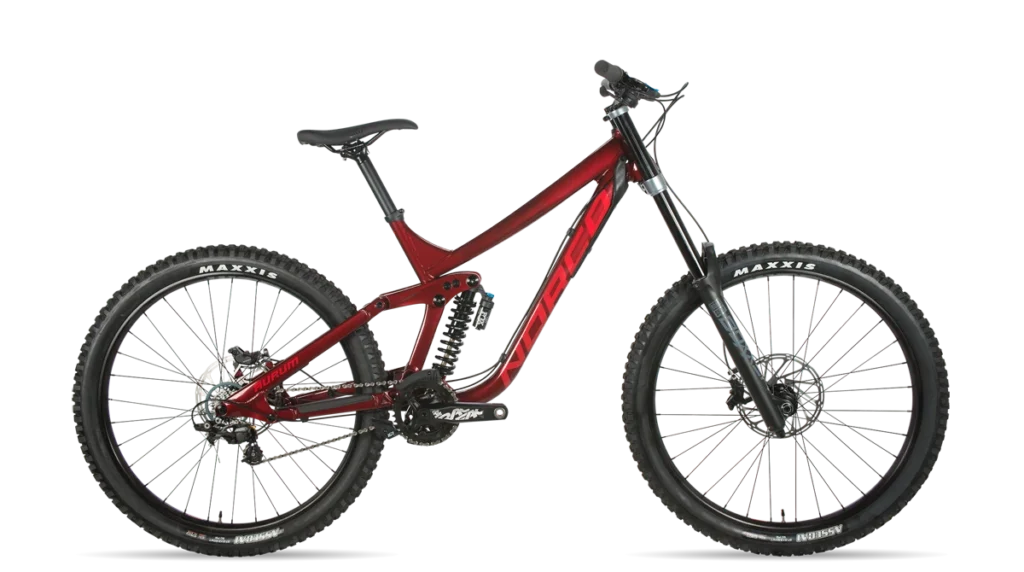
- Price: $6,999 – $8,500
- Suspension: 200mm rear, 200mm front
- Frame Material: Carbon
- Brakes: Shimano Saint 4-piston
- Drivetrain: SRAM GX DH 7-speed
- Wheel Size: 29”
PROS
CONS
- High-pivot suspension improves traction and control
- Plush and stable ride on rough tracks
- Well-balanced geometry for racing and bike park use
- Not the lightest downhill bike
- Takes time to adjust to high-pivot handling
10. Scott Gambler 920
The Scott Gambler 920 is one of the most versatile downhill bikes, offering a fully adjustable wheel setup and customizable geometry. Riders can switch between a full 29-inch setup for maximum speed or a mixed-wheel (mullet) setup for improved agility.
The aluminum frame is incredibly stiff and durable, making it a great option for riders who prioritize strength over weight savings. Scott’s adjustable geometry system allows riders to fine-tune head angle, reach, and chainstay length, making the Gambler adaptable to any downhill track.
One of the biggest advantages of the Gambler 920 is its affordability compared to high-end carbon models. While it may not be as light as the Pivot Phoenix or Santa Cruz V10, its adjustability and durability make it a fantastic choice for both racers and bike park riders.

- Price: $4,999 – $6,499
- Suspension: 200mm rear, 200mm front
- Frame Material: Alloy
- Brakes: Shimano XT 4-piston
- Drivetrain: SRAM GX DH 7-speed
- Wheel Size: Adjustable (29″ or Mullet setup)
PROS
CONS
- Adjustable wheel setup (29” or mullet)
- Strong, durable alloy frame
- Highly customizable geometry
- Heavier than some competitors
- Stock suspension could use tuning for aggressive riders
# | Product | Title | Rating | |
1 |  | Santa Cruz V10 2025 Edition | 4.9285714285714/5 | Check Price |
2 |  | Commencal Supreme DH V6 | 4.5714285714286/5 | Check Price |
3 |  | Canyon Sender CFR 2025 | 4.9285714285714/5 | Check Price |
4 |  | Trek Session 10 | 4.5/5 | Check Price |
5 |  | Pivot Phoenix 29 2025 | 4.7857142857143/5 | Check Price |
6 |  | Nukeproof Dissent 297 | 4.5/5 | Check Price |
7 |  | GT Fury Carbon Ultimate | 3.8571428571429/5 | Check Price |
8 |  | Specialized Demo Race 2025 | 4.5/5 | Check Price |
9 |  | Norco Aurum HSP C2 | 4.5/5 | Check Price |
10 |  | Scott Gambler 920 | 3.8571428571429/5 | Check Price |
Downhill Mountain Bike Buyers Guide
1. Suspension Travel
Suspension travel is one of the most critical aspects of a downhill bike. Most downhill bikes feature between 190mm and 220mm of travel, designed to handle the roughest terrains, large drops, and high-speed descents.
- Longer travel (200mm+): Best for extreme descents, high-impact riding, and racing.
- Shorter travel (190-200mm): Offers slightly more pedaling efficiency, suitable for mixed terrain.
2. Frame Material
The frame material directly impacts weight, durability, and ride feel.
- Carbon: Lighter, stiffer, and absorbs vibrations better, but at a higher cost.
- Aluminum: Heavier but more affordable and highly durable.
- Steel & Titanium (rare in DH bikes): Occasionally found in custom builds for unique ride characteristics.
3. Wheel Size
Choosing the right wheel size affects handling and speed.
- 29-inch wheels: Provide higher rolling efficiency, better traction, and improved speed.
- 27.5-inch wheels: More maneuverable and responsive, making them popular with freeriders.
- Mixed-wheel (Mullet setup): Combines the speed of a 29” front wheel with the agility of a 27.5” rear wheel.
4. Brakes & Drivetrain
Downhill bikes require powerful brakes and durable drivetrains to withstand extreme riding conditions.
- Brakes: Opt for 200mm hydraulic disc brakes for maximum stopping power.
- Drivetrain: Downhill bikes typically use 7-speed cassettes, prioritizing durability and simplicity.
5. Geometry & Adjustability
The geometry of a downhill bike influences its stability, handling, and rider comfort.
- Head tube angle (62-65 degrees): A slacker angle provides more stability at high speeds.
- Chainstay length: Adjustable chainstays help tailor handling for different tracks.
- Flip chips & shock mounts: Some bikes offer flip chips to fine-tune bottom bracket height and suspension kinematics.
6. Weight Considerations
Downhill bikes are heavier than other mountain bikes due to their reinforced frames and components.
- Lighter bikes (33-35 lbs): Easier to maneuver and better for riders who want agility.
- Heavier bikes (36-40 lbs): More durable and stable, ideal for aggressive descents.
7. Budget Considerations
The best downhill bikes span a wide price range:
- Under $3,000: Entry-level models with aluminum frames and mid-range components.
- $3,000 – $5,000: Mid-range bikes with better suspension and improved geometry.
- $5,000 – $8,000: High-end bikes with premium components and carbon frames.
- $8,000+: Elite race-ready bikes with cutting-edge technology and lightweight builds.
Final Thoughts
Downhill mountain biking is an exciting and challenging sport that requires the right equipment to ensure safety and peak performance. Whether you’re an experienced racer or a weekend warrior, choosing the right bike comes down to suspension travel, frame material, wheel size, and adjustability.
For those prioritizing speed and racing, bikes like the Santa Cruz V10 or Pivot Phoenix 29 are excellent choices. If budget is a concern, Commencal Supreme DH V5 and GT Fury A/M provide great value without sacrificing performance. Riders who want adjustability should consider models with flip chips and adjustable chainstays to fine-tune geometry based on terrain.
No matter your budget or riding style, investing in the right downhill bike ensures that you can ride harder, faster, and with more confidence on any trail.
